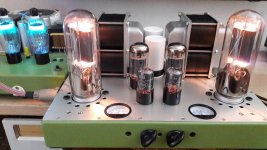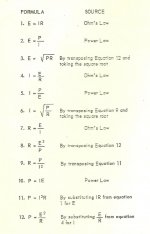Forgive me for any questions you may find silly .. but I have a mechanical engineering background ..
Anyways .. I want to build the new amp as 2 units ..with the PSU in one and the amp in the other .. my questions is , if I build the PSU. can I power it up without being connected to the amp ? , or will this cause a problem ..
Anyways .. I want to build the new amp as 2 units ..with the PSU in one and the amp in the other .. my questions is , if I build the PSU. can I power it up without being connected to the amp ? , or will this cause a problem ..
Besides the visual spectacle, I am expecting substantially lowered distortion compared to silicon diodes.
Mercury tubes are pretty noisy compared to vacuum rectifiers. Silicon Carbide diodes are about the cleanest diodes out there now.
For the lowest noise you could use a synchronous rectifier controller chip and four mosfets.
Definitely heed the Hg vapor warnings. You might use metal window screening for the Faraday cage. Most of the desired visual impact will be retained.
A pair of 6AX4s and a pair of 866s, whose filament voltages are different, strongly suggests a bridge rectifier to me.
An Octal Amperite thermal relay paired with an Octal plug in DPDT mechanical relay will give you a non-SS time delay for the Hg vapor tubes to get hot. "EBone" is where to get the Amperite part. The parts supply houses' price for glass envelope Amperite relays is high.
FWIW, the visual impact idea could be carried further by the use of gas discharge tube regulated B+ in the small signal circuitry.
I would probably use this... M-D Building Products 84327 .020-Inch Thick 3-Feet by 3-Feet Small Hole Aluminum Sheet, Black: Amazon.ca: Tools & Home Improvement
When using Amperite time delays, remember that it will take nn seconds for the contacts to make contact. But it will take about the same nn seconds before the contact is released. So if the power supply is switched ON and than OFF, make sure you wait the nn seconds yourself, before switching it back ON. Otherwise the delay is shortened, what could cause damage to your circuits.
I added a relay, that will bridge the contacts and switch off the heating of the Amperite delay.
Regards, Gerrit
My experience with these is even a 12V relay will cause a long time constant amperite to bounce... I would suggest using it for show only and using the contact to switch a transistor or something... Just my opinion... Or get fancy, and use a 6SN7 cathode follower and the amperite to trigger a relay with about a 25k coil resistance
Koda
Last edited:
I would probably use this... M-D Building Products 84327 .020-Inch Thick 3-Feet by 3-Feet Small Hole Aluminum Sheet, Black: Amazon.ca: Tools & Home Improvement
That stuff definitely has a "look" and cosmetics are definitely part of the OP's concept. Bronze window screening would give different "look". However, aluminum is less costly than bronze and money is always a consideration.
I'm repeatedly on record as intensely disliking Hg vapor rectifiers, for safety reasons. However, since they will be used, adequate preparations to deal with a broken envelope must be taken. Acquire some powdered sulfur and keep it close to where Hg vapor devices are in service. Sprinkling powdered sulfur on spilled mercury leads to rapid sequestration of the troublesome, toxic, substance. S and Hg combine to form mercuric sulfide (HgS), which is about the most insoluble stuff in existence. Boiling concentrated nitric acid will not attack HgS.
Silicon Carbide diodes are about the cleanest diodes out there now.
What I pay heed to is I-V characteristic. I consider silicon carbide diodes as very dirty. Noise is placed lower down.
Hi , thanks for the reply , yes I have that one but there’s info missing .. and I don’t have the knowledge to workout what is required ..
And I’m well aware of the results if mistakes are made ..
If someone can help me fill in the blank space so to speak that would be great 👍
Here's my mercury rectified supply:Hammond 159V choke input from CT to ground, 18uf>LL1638(re-wired in parallel)>30uf>5H>30uf, generating a loaded 520vdc@150mA, powering a low power L63>EL34>845 SET. DCG4/1000 same as 866A. Super quite and soothing!
Attachments
Thanks for the info , was going to power up the heaters , but how would you run them with load ???
That is a good question, I have a pair of 866A and I have run them just heaters, they get hot but I see no glow of any kind, is that normal? You only get the full on glow running them full on rectifying with a load?
That is a good question, I have a pair of 866A and I have run them just heaters, they get hot but I see no glow of any kind, is that normal? You only get the full on glow running them full on rectifying with a load?
No load no glow!! I used a 2K2/25w resistor to loaded.
You should not run the supply unloaded because the provided voltage output will be substantially higher and will stress the supply's filter capacitors. But you can simulate the amplifier's load with a suitable power resistor. Simple ohm's law (#7) will give you the value once you determine the desired voltage and current. Unfortunately this requires other calculations, or good estimates.my questions is , if I build the PSU. can I power it up without being connected to the amp ? , or will this cause a problem ..
However if you have the various transformers for the supply, you could make a temporary setup to power and test an 866. A 2.5 volt filament transformer will light the tube. Give it a full sixty seconds or more to heat up. You will notice the tube becoming cloudy from the mercury vapor build up. This is normal. Connect a plate supply transformer to form a half wave rectifier using the tube. You don't need high voltage for this test. 20 to 40 volts will work well. And no filter caps are necessary for this.
If you don't know what a half wave rectifier circuit is, you probably shouldn't be doing any of this.
Connect a suitable power resistor across the output (cathode to ground), depending on the voltage you will be testing with, to consume one (1) ampere of current. (Example: for 25 volts use 25 ohms at 25 watts, or more) The tube will turn blue in color and get hot. Carefully watch the tube's plate for signs of a blistering coating and peeling or flaking. If none of this happens after a couple of minuets, you're good to go. If it does flake off there may be a flash or pop if the residue gets between the cathode and plate. The round cylinder below the plate is connected to the cathode that's inside. You could even go for more then one amp if you're limited in available parts. A variac in the plate supply transformer is a good idea. If you don't have a 5 amp variac or better, you should have one if you're going to work with tube amps.
Actually I forgot about the 15 volt tube drop so you'll want to use a little higher voltage source. Say about 50 volts.
Attachments
Last edited:
You may also want to read through the other recent post in this sub-forum that is using an 83 rectifier - well in fact that OP has used a few 83's now, so well worth appreciating how easily and quickly this type of rectifier tube can fail.
Link: Help please: Bias and hum
Link: Help please: Bias and hum
You should not run the supply unloaded because the provided voltage output will be substantially higher and will stress the supply's filter capacitors. But you can simulate the amplifier's load with a suitable power resistor. Simple ohm's law (#7) will give you the value once you determine the desired voltage and current. Unfortunately this requires other calculations, or good estimates.
However if you have the various transformers for the supply, you could make a temporary setup to power and test an 866. A 2.5 volt filament transformer will light the tube. Give it a full sixty seconds or more to heat up. You will notice the tube becoming cloudy from the mercury vapor build up. This is normal. Connect a plate supply transformer to form a half wave rectifier using the tube. You don't need high voltage for this test. 20 to 40 volts will work well. And no filter caps are necessary for this.
If you don't know what a half wave rectifier circuit is, you probably shouldn't be doing any of this.
Connect a suitable power resistor across the output (cathode to ground), depending on the voltage you will be testing with, to consume one (1) ampere of current. (Example: for 25 volts use 25 ohms at 25 watts, or more) The tube will turn blue in color and get hot. Carefully watch the tube's plate for signs of a blistering coating and peeling or flaking. If none of this happens after a couple of minuets, you're good to go. If it does flake off there may be a flash or pop if the residue gets between the cathode and plate. The round cylinder below the plate is connected to the cathode that's inside. You could even go for more then one amp if you're limited in available parts. A variac in the plate supply transformer is a good idea. If you don't have a 5 amp variac or better, you should have one if you're going to work with tube amps.
Actually I forgot about the 15 volt tube drop so you'll want to use a little higher voltage source. Say about 50 volts.
Thank you very much ..very clear and understood ..🙏 As for the Sulphur .. I use it in the garden .. I was unaware of its possible use with Valve Amps though 😂
Starting at page 65 is a very detailed explanation of mercury vapor tubes including the filter design. http://www.tubebooks.org/tubedata/tt4.pdf
Starting at page 65 is a very detailed explanation of mercury vapor tubes including the filter design. http://www.tubebooks.org/tubedata/tt4.pdf
Oh that’s a good book 📚.
 Many thanks ..
Many thanks ..Thanks guys ...for your help with this project .. believe me ...I’m well aware of H&S issues , and I don’t go ploughing into any projects without getting a much better understanding of what I’m doing . I’m never going to be a an amp designer , but would like to gain the confidence to understand the schematic and build safely ...
Your help in my learning curve is very much appreciated.. Brian
Your help in my learning curve is very much appreciated.. Brian
- Status
- This old topic is closed. If you want to reopen this topic, contact a moderator using the "Report Post" button.
- Home
- Amplifiers
- Tubes / Valves
- Tube rectified PSU


